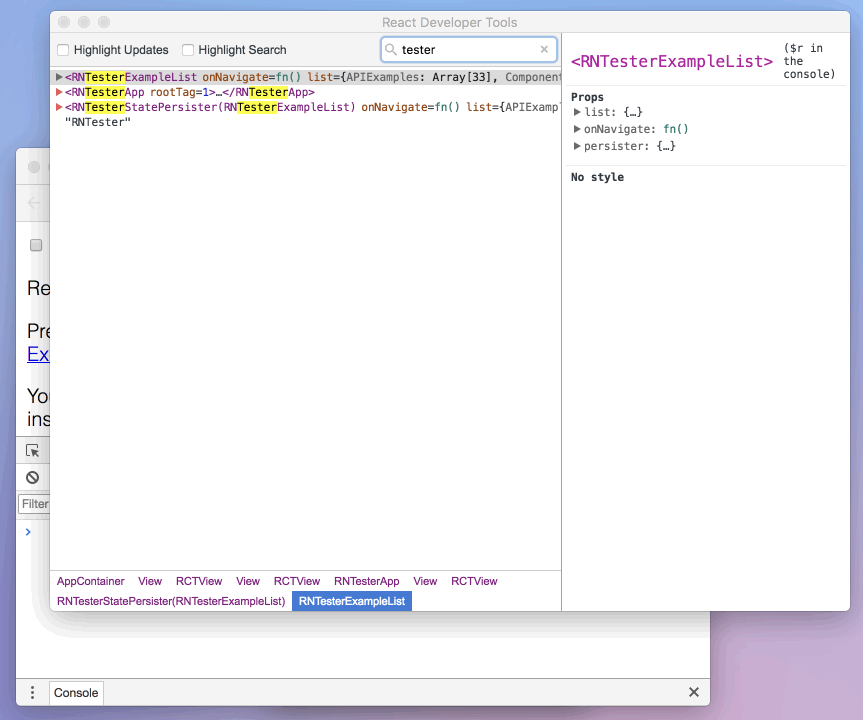@textio/react-devtools v3.4.6
react-devtools
If you need to debug a React page somewhere other than Chrome on desktop (a mobile browser, an embedded webview, Safari, etc), the react-devtools package is for you! It is also useful if your app is inside an iframe.
It works both with React DOM and React Native.
Usage with React Native
Install the react-devtools package globally:
with yarn:
yarn global add react-devtoolsor with npm:
npm install -g react-devtoolsNow run react-devtools from the terminal to launch the standalone DevTools app:
react-devtoolsIf you're not in a simulator then you also need to run the following in a command prompt:
adb reverse tcp:8097 tcp:8097If you're using React Native 0.43 or higher, it should connect to your simulator within a few seconds.
Note: if you prefer to avoid global installations, you can add
react-devtoolsas a project dependency. With Yarn, you can runyarn add --dev react-devtools, and then runyarn react-devtoolsfrom your project folder to open the DevTools. With npm, you can runnpm install --save-dev react-devtools, add"react-devtools": "react-devtools"to thescriptssection in yourpackage.json, and then runnpm run react-devtoolsfrom your project folder to open the DevTools.
Integration with React Native Inspector
You can open the in-app developer menu and choose "Show Inspector". It will bring up an overlay that lets you tap on any UI element and see information about it:

However, when react-devtools is running, Inspector will enter a special collapsed mode, and instead use the DevTools as primary UI. In this mode, clicking on something in the simulator will bring up the relevant components in the DevTools:

You can choose "Hide Inspector" in the same menu to exit this mode.
Inspecting Component Instances
When debugging JavaScript in Chrome, you can inspect the props and state of the React components in the browser console.
First, follow the instructions for debugging in Chrome to open the Chrome console.
Make sure that the dropdown in the top left corner of the Chrome console says debuggerWorker.js. This step is essential.
Then select a React component in React DevTools. There is a search box at the top that helps you find one by name. As soon as you select it, it will be available as $r in the Chrome console, letting you inspect its props, state, and instance properties.

Usage with React DOM
The standalone shell can also be useful with React DOM (for example, to debug apps in Safari, or inside an iframe).
Install the react-devtools package globally:
with yarn:
yarn global add react-devtoolsor with npm:
npm install -g react-devtoolsNow run react-devtools from the terminal to launch the standalone DevTools app:
react-devtoolsFinally, add <script src="http://localhost:8097"></script> as the very first <script> tag in the <head> of your page when developing:
<!doctype html>
<html lang="en">
<head>
<script src="http://localhost:8097"></script>This will ensure the developer tools are connected.
Don’t forget to remove it before deploying to production!
Note: if you prefer to avoid global installations, you can add
react-devtoolsas a project dependency. With Yarn, you can runyarn add --dev react-devtools, and then runyarn react-devtoolsfrom your project folder to open the DevTools. With npm, you can runnpm install --save-dev react-devtools, add"react-devtools": "react-devtools"to thescriptssection in yourpackage.json, and then runnpm run react-devtoolsfrom your project folder to open the DevTools.If you install
react-devtoolsas a project dependency, you may also replace the<script>suggested above with a JavaScript import (import 'react-devtools'). It is important that this import comes before any other imports in your app (especially beforereact-dom). Make sure to remove the import before deploying to production, as it carries a large DevTools client with it. If you use Webpack and have control over its configuration, you could alternatively add'react-devtools'as the first item in theentryarray of the development-only configuration, and then you wouldn’t need to deal either with<script>tags orimportstatements.
Advanced
By default DevTools listen to port 8097 on localhost.
If you need to customize host, port, or other settings, see the react-devtools-core package instead.
Developing
- Run
yarn run backend:watchandyarn run standalone:watchin../react-devtools-core - Run
yarn startin this folder - Refresh the app after it has recompiled on change
- For React Native, copy
react-devtools-coreto itsnode_modulesto test your changes